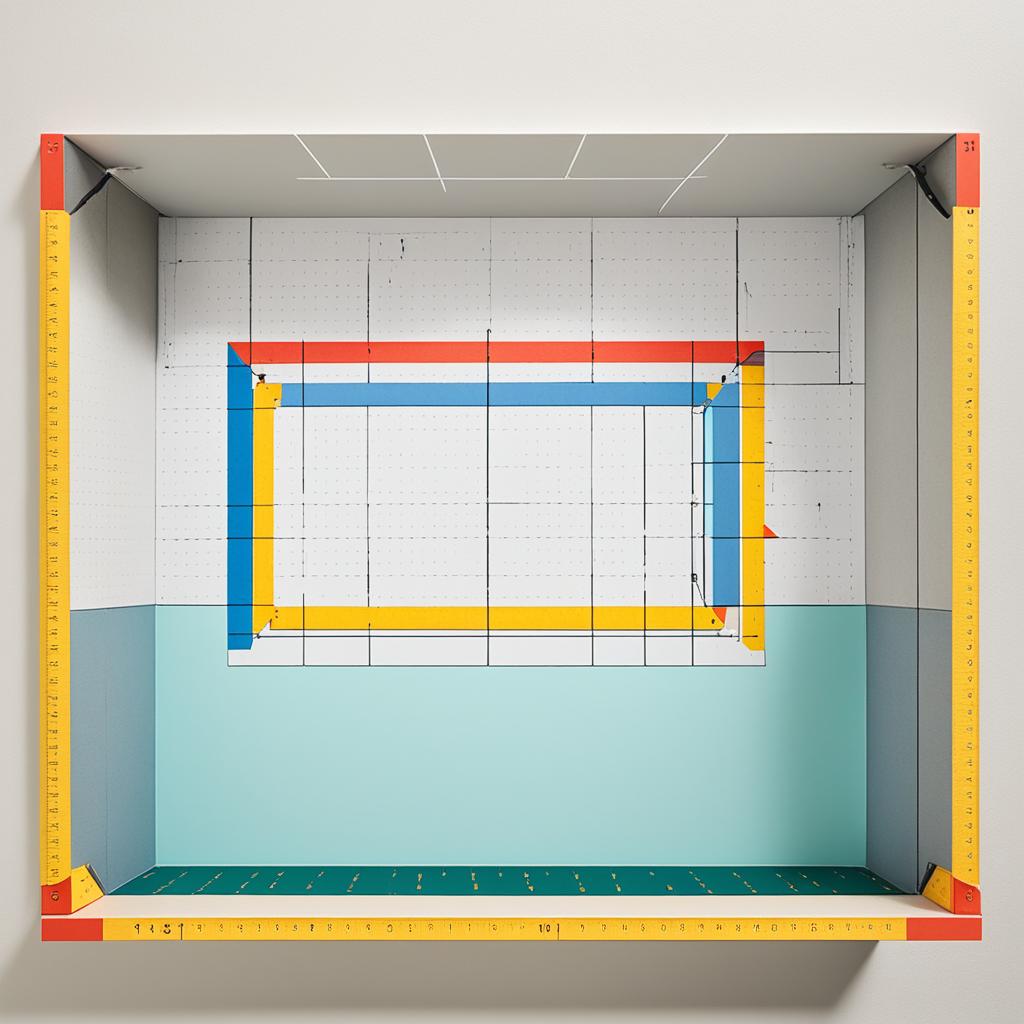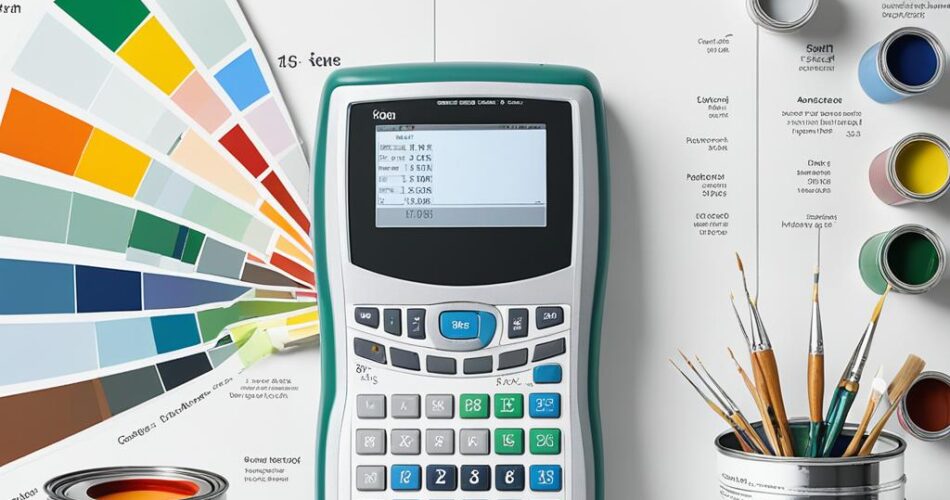Estimating paint amounts can be tricky. A paint calculator helps you figure out how much paint you need. This tool uses your room’s square footage to estimate paint quantity.
Paint calculators consider room dimensions, walls, doors, and windows. They use the rule that one gallon covers about 350 square feet. For a 12×12 room with an 8-foot ceiling, you’d need about 2 gallons.
Using a paint estimator is easy. You input your space’s measurements, and it does the math. It accounts for doors (20 square feet) and windows (15 square feet).
The calculator adjusts for L-shaped rooms too. These rooms have six wall surfaces instead of four. Remember, surface texture and color changes may require more paint.
It’s smart to order 10-20% extra paint. This covers touch-ups and unexpected needs. Paint coverage can vary, so it’s better to have some extra.
Key Takeaways
- Paint calculators help estimate paint quantity based on room dimensions
- One gallon of paint typically covers 350-400 square feet
- Factors like doors, windows, and room shape affect paint calculations
- L-shaped rooms have six wall surfaces to consider
- It’s recommended to order 10-20% extra paint for touch-ups
Understanding the Basics of Paint Coverage
Paint coverage is key in any painting project. It helps you save time, money, and reduce waste. Let’s explore how paint coverage affects your project’s cost.
The 400 Square Feet Rule
One gallon of paint typically covers 400 square feet with one coat. This rule helps estimate paint quantity quickly. For instance, a 12×12 room with 8-foot ceilings might need 2 gallons for two coats.
Factors Affecting Paint Coverage
Several factors can impact paint coverage:
- Surface texture: Rough surfaces need more paint
- Paint quality: Premium paints often cover more area
- Color changes: Darker colors may require extra coats
- Application method: Rollers and brushes affect coverage

Importance of Accurate Estimation
Accurate paint estimation is crucial for a successful project. It helps with budgeting and time management. Proper planning prevents mid-project store runs.
Buying the right amount minimizes leftover paint. Using a wall coverage calculator can improve your surface area calculation accuracy. It’s wise to buy 10% more paint than your initial estimate.
| Surface Type | Coverage (sq ft/gallon) |
|---|---|
| Interior Walls | 350-400 |
| Exterior Walls | 250-300 |
| Primer | 200-300 |
How to Measure Your Space for Painting
Precise room measurements are key to a successful painting project. Let’s explore how to measure walls correctly. This ensures you’ll get the right amount of paint.
Begin by measuring each wall’s height and width. For rectangular rooms, measure all four walls. L-shaped rooms have six surfaces to consider. Remember to measure doors and windows too.

For ceilings, measure length and width. Use these numbers in a painting area calculator. This will give you the total paintable surface area. A gallon of paint usually covers 350-400 square feet.
- Bedrooms average around 800 square feet, often requiring 2-3 gallons of paint per coat.
- Doors need about 20 square feet of paint coverage each.
- Windows usually require 15 square feet of paint.
Accurate measurements help estimate paint needs and budget. They also help assess timeline, labor, and resources needed. This makes project planning easier.
“Measure twice, paint once. Precise measurements are the foundation of a successful painting project.”
Knowing your room dimensions is crucial. Using a reliable area calculator helps too. These steps will prepare you for your next painting project.
The Paint Calculator: Your Digital Estimation Tool
Paint calculators have changed how we plan painting projects. These online tools make estimating paint quantities easy. They save time and reduce waste.
Let’s explore the features and benefits of using a paint estimator. It can help with your next painting project.
Features of Online Paint Calculators
Modern paint calculators offer helpful features:
- Room shape selection
- Wall dimension input
- Adjustments for windows and doors
- Options for ceiling paint
- Calculations for multiple coats
How to Use a Paint Calculator Effectively
To get the most out of your online paint quantity calculator:
- Measure your space accurately
- Input correct dimensions
- Account for windows and doors
- Consider surface condition
- Factor in paint quality
Benefits of Using a Paint Calculator
A painting project planner offers many advantages:
| Benefit | Description |
|---|---|
| Time-saving | Quick estimations without manual calculations |
| Cost-effective | Reduces paint waste and unnecessary purchases |
| Accuracy | Precise estimates based on room dimensions |
| Project planning | Helps in budgeting and scheduling |
A paint job calculator can streamline your painting process. It ensures you have the right amount of paint. You can avoid costly mistakes.
This digital tool is valuable for DIY fans and professional painters. It helps make painting projects smoother and more efficient.
Paint Calculator
Calculating Paint Needs for Different Surfaces
Different surfaces need varying amounts of paint. A paint surface area calculator helps determine the right quantity for each unique surface. This tool saves time and money on your painting project.
Walls usually need more paint than ceilings. For a standard room, use this formula:
Room Surface Area = Length × Width × Height
Subtract door and window areas for accuracy. Textured surfaces may need 50% more paint than smooth ones. For furniture, calculate all sides to be painted.
Exterior surfaces often require more paint due to weathering. An exterior paint calculator accounts for these factors. Typically, 4 liters cover up to 40 square meters (400 sq. ft).
Interior paint calculators factor in surface texture and paint quality. They use formulas like:
Amount of Paint Needed = Surface Area × Number of Coats / 572
These tools ensure you have the right amount of paint for any surface. They consider variables like texture and number of coats needed.
Adjusting Calculations for Multiple Coats
Planning a painting project? Consider the need for multiple coats. A paint volume calculator helps estimate paint amounts. Knowing how to adjust for multiple coats ensures a successful paint job.
When to Apply Multiple Coats
Multiple coats are often needed for full color coverage. This is true for drastic color changes or painting over dark shades. Most projects require at least two coats for best results.
In some cases, three coats may be needed for a longer-lasting finish. This depends on the surface and paint quality.
How Multiple Coats Affect Paint Quantity
Each additional coat increases the total paint needed. A paint material estimator is crucial for accurate calculations. For example, a medium-sized room typically needs two gallons of paint.
If you’re applying two coats, you’ll need to double that amount. This ensures complete coverage and a professional finish.
Calculating for Primer Application
Primer is essential in many painting projects. It usually covers less area than regular paint, about 200-300 square feet per gallon. Factor in primer separately when using a painting cost estimate tool.
For instance, Interior Wood Primer & Undercoat covers about 60m² per 5 liters per coat. This helps in accurate material estimation.
| Paint Type | Coverage per 5L | Recommended Coats |
|---|---|---|
| Estate Emulsion | 70m² | 2 |
| Modern Emulsion | 60m² | 2 |
| Exterior Masonry | 40m² | 2 |
| Interior Wood Primer | 60m² | 1 |
It’s smart to order 10-20% extra paint for touch-ups. This extra paint accounts for absorbed quantities on porous surfaces. You’ll have enough paint for complete coverage without running short mid-project.
Considering Paint Quality in Your Calculations
Paint quality is vital when using a painting supplies estimator. High-grade paints often cover better, reducing the number of coats needed. This can greatly affect your paint calculations and project costs.
Premium paints typically cover up to 400 square feet per gallon. Budget options might cover less area. When estimating, consider the paint’s volume solids and dry film thickness.
These factors influence how much area a gallon can cover effectively.
| Paint Quality | Coverage (sq ft/gallon) | Coats Needed | Durability |
|---|---|---|---|
| Premium | 350-400 | 1-2 | High |
| Mid-range | 300-350 | 2 | Medium |
| Budget | 250-300 | 2-3 | Low |
Premium paints may seem costly at first but can save money later. They offer better coverage, meaning less paint used overall. Their improved durability also reduces how often you need to repaint.
Keep these factors in mind when using your painting supplies estimator. This ensures accurate calculations and the best results for your project.
Special Considerations for Exterior Painting Projects
Exterior painting projects require unique planning. An exterior painting calculator can help estimate your paint needs and costs accurately.
Accounting for Surface Texture
Surface texture affects paint coverage significantly. Smooth surfaces like vinyl siding cover more area per gallon. Rougher textures like stucco require more paint.
BEHR paints, popular for exterior projects, cover 250-400 square feet per gallon. The coverage varies depending on the product line.
Weather Factors in Exterior Painting
Weather conditions impact paint application and drying time. Extreme temperatures or high humidity can affect paint adhesion. This may change your exterior paint needs.
Consider using a house painting cost estimator that accounts for local weather patterns.
Calculating for Trim and Accents
Remember to calculate trim and accents separately. These areas often need different paint types and extra coats. Use an exterior painting calculator to ensure sufficient paint for all project elements.
| Surface Type | Coverage (sq ft/gallon) | Paint Cost Range |
|---|---|---|
| Smooth Exterior | 300 | $25-$50 |
| Textured Exterior | 200-250 | $30-$60 |
| Trim and Accents | 250-300 | $40-$80 |
It’s wise to slightly overestimate your paint needs. Rounding up calculations prevents running out mid-project. This approach saves time and reduces frustration.
Tips for Accurate Paint Estimation
Precise paint estimation is vital for successful project planning. Start by measuring each wall separately. Don’t forget to account for doors and windows.
When using a paint estimation tool, add 10% extra. This buffer covers touch-ups and spills. Consider the paint’s sheen too, as glossier finishes may cover less area.
Quality tools are crucial for even paint coverage. Good roller covers can help spread paint efficiently. For complex projects, seek advice from paint shop experts.
“Proper estimation is crucial for a successful painting business, emphasizing the need for accurate estimating processes to avoid lost bids or financial losses.”
Exterior painting requires special attention. Weather and surface texture affect paint absorption. Factor these elements into your calculations.
These tips will help your painting project planning be spot-on. You’ll save both time and money in the process.
- Measure each wall individually
- Account for doors and windows
- Add 10% extra for touch-ups
- Consider paint sheen
- Use quality tools
- Consult professionals when needed
Conclusion
A paint calculator is a must-have for any painting project. It helps you figure out how much paint you need. This tool saves you time and money by giving accurate estimates.
Paint calculators look at surface area and number of coats. They also consider paint coverage to give precise results. With these tools, estimating paint quantity becomes easy.
These calculators factor in room size and openings like doors. This ensures you buy just the right amount of paint. A gallon usually covers 350-400 square feet, but this can change.
Wall area calculators help both DIY fans and pro painters. They prevent common errors like forgetting multiple coats or ceiling areas. Newtum’s free Paint Calculator is a great example.
With these tools, you can approach your next paint job with confidence. You’ll have accurate estimates and a clear plan ready to go.
